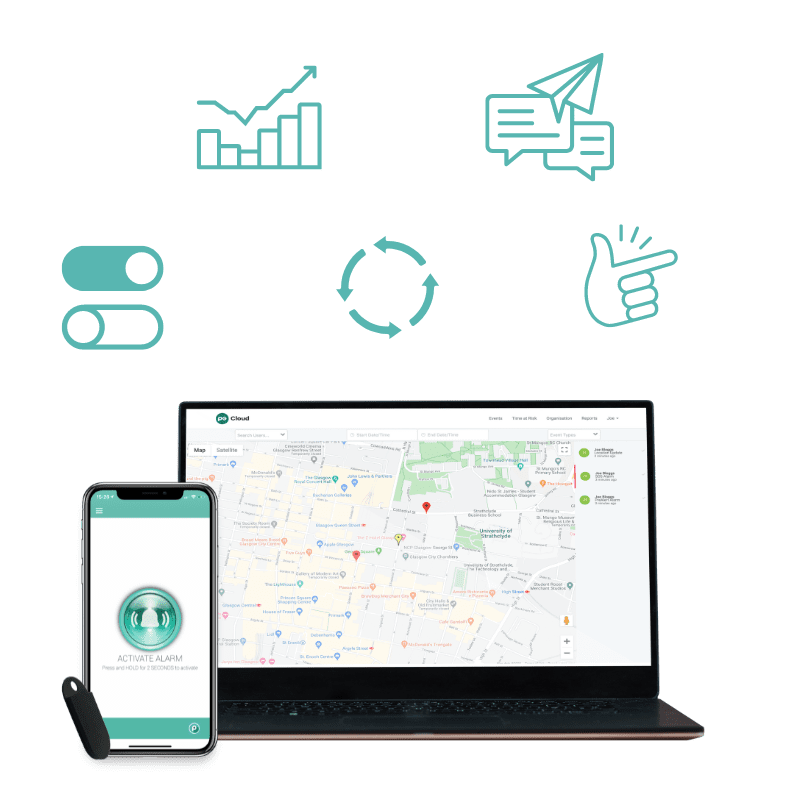
Why choose us?
Having a reliable lone worker device or app and customisable solution in place is only part of what makes for robust lone worker protection.
See how we ensure a secure and reliable system, high usage rates and a lone worker solution that fits in with your organisation.
Working with your organisation
Do you have an existing lone worker solution in place? Our in-house product team will work to integrate this with your chosen lone worker solution to make it work for you.
We keep in regular contact with our customers to understand what would be helpful to them, and take this feedback to our product development team. This way, you benefit from continuous and automatic product enhancements, at no extra cost.
Support and onboarding
There are no extra fees for implementation. Customisation and initial training is free, and we tailor our tried and tested four-phase introduction process to your requirements.
Not only will you have access to user guides, training materials and explainer videos via the PG Academy, we will also set up regular user adoption meetings.
Here, we establish targets and offer advice on proven usage strategies when usage is low.
Explore our onboarding process ➡
Phase 1
Engagement – what are the objectives and timelines? We’ll take a look at this in our initial kick-off meeting, along with any risks that need to be addressed.
Phase 2
Initiation – time to look at training targets, and review these against milestones. During this step, we’ll check-in with the prevention of risks noted during phase one.
Phase 3
Training – here, we’ll identify your service “champions”, and give them comprehensive training to support their colleagues. We’ll also confirm everyone has engaged with training before moving onto Phase 4.
Phase 4
Follow-up – only now will we confirm that you and your team are ready for our service to start, but we don’t leave things there. We keep in touch regularly to ensure everyone is using the system.

High standards in reliability
All of our Alarm Receiving Centres are NSI Gold standard and BS8484 acredited. This means they meet the security industry’s highest technical standards, and maintain continual improvement.
We use Amazon Web Servers, each of which has multiple instances. This allows for rapid scaling and failover, while each AWS also has automatic re-start capability.
FAQ
What is the difference between monitored and self-monitored, and which is right for my organisation?
Monitored means we will provide the Alarm Recieving Centre (ARC) part of the system. Self-Monitored is if your business already has such as facility in place, or you would prefer to have an SOS come through to named contacts within your organisation.
Which product is best for my company?
Our PG Smart App is the most popular product. It’s easy to use, and most people have a smartphone. However, a PG Click can be a useful addition if discretion is needed when raising an SOS, and a PG Pebble is a standalone device, if your team members are unable to carry smartphones. Our PG X is for those working in incredibly remote locations, where satellite communication is necessary.
Are apps as high quality protection as dedicated devices?
Yes. Our PG Smart App is incredibly effective, as it can switch across different cellular and data networks, and have the benefit of an in built antenna. It works across 2G, 3G, 4G and 5G.
Does it work in areas of no signal?
If you’re in a total connection blackspot, the PG X, which uses satelite communication, is the best option. This will works by using satellite communication, and so the user will need to be outside, in line of site of a satellite. The PG Smart App has good coverage even in areas of low signal, as it works across both cellular and data networks.
Legally, do I need a lone worker solution? Isn’t providing mobile phones enough?
There’s no legal requirement to put something in place. But if something were to happen, then the Health and Safety Executive would have to investigate. They would look at a risk assessment, and if the risk was not identified, then you’ve not carried out due diligence. If it had been identified, the HSE would ask what has been done to mitigate the risk, and whether providing a mobile phone is adequate.
What are the different training options?
We provide training through PG Academy, where you can download resources and guides. We also offer training sessions up to 25 people over video conference and refresher training. Slide decks are available for allocated employees through our train the trainer programme.
My employees will think I’m trying to track them. How do you make them feel comfortable with the system?
Our system only registers someone’s location when a user interacts with the portal. As a manager, you can press a locate now button if you’re concerned, but if the employee is not comfortable with this, they can close the app.
Our lone worker usage policy can be added as an appendix to lone worker policy. This makes it clear how the manager or employer should use the location function, with a paragraph explaining this won’t be used against the employee.
What reporting do you provide?
You are able to see usage among your team members, and details around “events” on the PG Cloud management portal. These can be SOS Alerts, Time at Risk Alerts, Pre-Alerts or Fall Detection. The events can be filtered by type, date and employee, and you can set the system to automatically email you reports on a regular basis.
